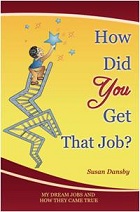 How many drafts of that career change cover letter have you done?
How many drafts of that career change cover letter have you done?
It’s tough, isn’t it?
That letter’s got to introduce you, explain why all your experience is in some other field, and reassure that possible employer you have what it takes to do the job you’re applying for – even if your resume doesn’t reflect it.
Well, the following sample career change cover letter (see below) does all that. The key – as with any cover letter – is having certain facts at hand before you start.
Fully research your new career. Talk to people who have done or are doing the job you want. That way you can make the letter specific instead of generic. Specificity impresses prospective employers – especially in competitive fields. They get dozens of vague cover letters every day.
Also See:
Afraid to Risk Finding A New Career When You’re Over 30?
How Your Life Story Can Amp Up Your Job Search
Once you’ve gotten information from your research (i.e., job duties and responsibilities, mandatory training and skills, whether the work place is high-pressured or low-key, etc.) writing a letter to a prospective employer is child’s play.
But this sample letter comes with a warning: Until you’ve spoken to at least one person in this new field who’s at the same level (or above) the person you’re writing, I wouldn’t write to ask for a job. Instead, I’d request a 15-minute informational interview.
This may seem unnecessary or time-consuming; but think about how car salespeople work. From the time you enter a car lot, that salesperson is getting a feel for what you, the buyer, want. “What’s most important, safety, style or mileage?” “Convertible or sedan?” “Carpooling or off-roading?
Just like that car salesperson, you’ve got a product you can present in any number of ways. Find out what’s most important to your buyer (prospective employer) before you start selling.
What follows is an example/sample of a career change cover letter asking for that 15-minute informational interview, and an explanation of the eight points that should be in the letter.
Dear Ms. Smith:
My name is Joan Doe, and Joe Jones (1) suggested I write you.
I’ve had many years of experience as a kindergarten teacher, and loved that job because I enjoy helping children excel. In fact, I was named Teacher of the Year last year.(2)
However, after ten years, I’ve become interested in pursuing a job in the customer service field. This might seem like a huge leap, but for the past 15 years, I’ve spent my spare time volunteering in customer service at our local youth center.(3)
I’ve enjoyed providing technical assistance, troubleshooting, and supporting the various computer applications. And at this point in my life (my own children are grown), I find I’d prefer to work with adults in a business environment. (4)
Toward that end, I’m trying to get as much information as possible about the customer service industry. I was hoping you, as a fellow alumnus,(5) would have 15 minutes to talk to me about the skills I might need, and any further studies I should pursue, to achieve my goal.(6)(7)
I’m enclosing my resume as a means of introduction.(8) I’m hoping you can spare the time to meet with me, Ms. Smith, I could really use the guidance.
Sincerely,
Joan Doe
Now, let’s deconstruct this letter to analyze the points covered here:
- You should have at least one personal contact you share with the person you’re writing – someone with whom they’ve worked in the past, or went to school with, or a relative. This isn’t as difficult to accomplish as it may seem. Ask that person if it’s okay to mention them in your cover letter.
- Give information about what you liked about your previous career, and why you were good at it.
- Explain why you’re changing careers. Never, ever mention anything negative about your old job here. That will only end up painting you in a bad light. By stating why you loved your old job and what you think you’ll like about your new job, you’ll establish that you’re not a flake, and have sound reasons for wanting a change.
- Show that you have some understanding of what’s entailed in the new career.
- Reference a second connection (i.e., school, church, civic organizations). This not only proves that you have something in common, it also proves you’re not some random person who pulled the potential employer’s name out of a hat.
- Ask for a 15-minute informational interview.
- Admit that you might not be quite ready to take on this new job – and that you may have things to learn. This takes the pressure off both you and the potential employer; and reiterates you’re not asking for a job in this interview!
- Enclosing your resume gives the potential employer an idea of how you’ve applied yourself in the past, and offers you the opportunity to list colleagues you have in common as references.
How do you find those connections? How do you make sure you’re so well versed in the details of your new career that you can impress any prospective employer? How do you follow up on the letter? What do you ask when you’re actually in that information interview? It’s all laid out for you in How Did You Get That Job.
By the way, I’ve sent about 20 letters like this over the course of my career, and got replies from maybe six people. Those six replies led to 26 years of great jobs.
On the other hand, there are people out there who send out hundreds of cover letters and resumes, get no replies, and no job. Use the job search system that works. Buy How Did You Get That Job today.

